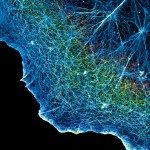Lien vers Pubmed [PMID] – 35867254
Lien DOI – 10.1007/978-1-0716-2497-5_13
Methods Mol Biol 2022 ; 2532(): 275-290
Hi-C and related sequencing-based techniques have brought a detailed understanding of the 3D genome architecture and the discovery of novel structures such as topologically associating domains (TADs) and chromatin loops, which emerge from cohesin-mediated DNA extrusion. However, these techniques require cell fixation, which precludes assessment of chromatin structure dynamics, and are generally restricted to population averages, thus masking cell-to-cell heterogeneity. By contrast, live-cell imaging allows to characterize and quantify the temporal dynamics of chromatin, potentially including TADs and loops in single cells. Specific chromatin loci can be visualized at high temporal and spatial resolution by inserting a repeat array from bacterial operator sequences bound by fluorescent tags. Using two different types of repeats allows to tag both anchors of a loop in different colors, thus enabling to track them separately even when they are in close vicinity. Here, we describe a versatile cloning method for generating many repeat array repair cassettes in parallel and inserting them by CRISPR-Cas9 into the human genome. This method should be instrumental to studying chromatin loop dynamics in single human cells.


